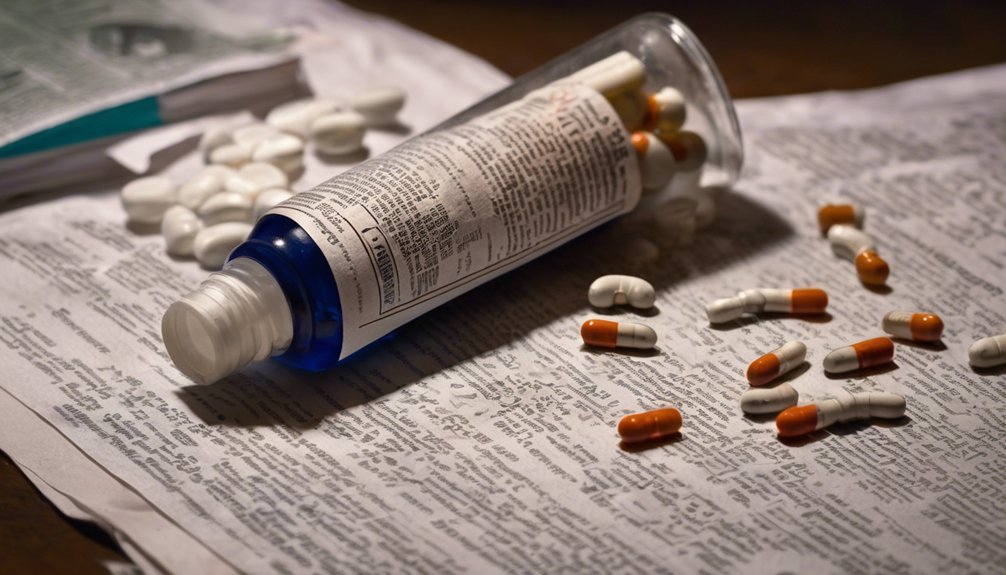It’s a coincidence that Ivermectin, once celebrated for its anti-parasitic properties, became a focal point in the fight against COVID-19. As conflicting study results emerged, the path to regulatory approval grew increasingly complex. This situation underscores a critical need for established guidelines that ensure both safety and efficacy in drug repurposing. What lessons can be drawn from Ivermectin’s journey to inform future regulatory practices?
Key Takeaways
- Ivermectin’s mixed efficacy results highlight the need for clear regulatory guidelines to navigate repurposing challenges effectively.
- Conflicting study outcomes emphasize the importance of evidence-based practices to inform regulatory decisions on repurposed drugs.
- Safety concerns surrounding Ivermectin’s off-label use stress the necessity for robust safety assessments in regulatory frameworks.
- Global variations in approval guidelines illustrate the need for harmonized regulations to facilitate the repurposing of drugs like Ivermectin.
- Ethical considerations, such as informed consent and equitable access, must be prioritized in regulatory pathways for repurposed drugs.
Understanding Drug Repurposing

When you consider the rapidly evolving landscape of drug development, understanding drug repurposing becomes essential. This approach leverages existing drugs, examining their drug mechanisms, safety profiles, and treatment indications for new therapeutic uses.
You’ll find that thorough scientific validation can enhance market access, especially when addressing diverse patient demographics. Regulatory frameworks play a crucial role in streamlining approval timelines and ensuring compliance with therapeutic guidelines.
The Role of Ivermectin in COVID-19 Treatment
Although ivermectin gained attention as a potential treatment for COVID-19, its efficacy and safety have sparked considerable debate within the medical community. Many studies have explored ivermectin’s role, yet results remain inconclusive. Some early reports suggested antiviral properties, leading to its inclusion in treatment guidelines; however, subsequent rigorous trials often failed to demonstrate significant benefits.
Organizations like the WHO and FDA have cautioned against its use outside clinical trials due to insufficient evidence.
As healthcare providers, understanding the nuances of ivermectin efficacy is crucial for guiding patient care. It’s important to stay informed about evolving treatment guidelines and to prioritize evidence-based practices in your approach to COVID-19 management, ensuring that patient safety remains at the forefront of your decisions.
Historical Context of Ivermectin Use
Ivermectin has a rich history that predates its recent spotlight during the COVID-19 pandemic. Understanding its origins and historical applications can shed light on its significance:
- Discovery: Ivermectin was derived from a soil bacterium, Streptomyces avermitilis, in the late 1970s.
- Initial Use: It was first approved in 1987 for treating parasitic infections in animals, marking a breakthrough in veterinary medicine.
- Human Applications: By the 1990s, it gained approval for human use, notably for onchocerciasis (river blindness) and lymphatic filariasis.
- Global Impact: Ivermectin has been instrumental in public health initiatives, helping to reduce morbidity in affected populations worldwide.
This historical context highlights the drug’s established role in treating parasitic diseases before its recent controversial discussions.
Clinical Trials: A Double-Edged Sword

While clinical trials are essential for validating the efficacy and safety of repurposed drugs like ivermectin, they can also present significant challenges.
Effective clinical trial design is crucial; poor design can lead to inconclusive results, hampering the quest for regulatory approval. You must ensure that trials are well-structured and address relevant endpoints to provide reliable data.
Moreover, navigating the regulatory landscape can be daunting, as differing guidelines across jurisdictions may complicate your efforts. As a result, you might face delays in patient access to potentially beneficial therapies.
Ultimately, while clinical trials are pivotal in establishing a drug’s value, their execution can significantly influence the trajectory of repurposed drugs, impacting both scientific outcomes and public health.
Regulatory Challenges Faced by Ivermectin
When considering the regulatory challenges surrounding ivermectin, it becomes clear that the drug’s mixed reputation complicates its approval process.
You’ll encounter several regulatory hurdles and safety concerns that impact its use:
- Mixed Evidence: Conflicting study results create uncertainty regarding efficacy.
- Public Perception: The drug’s promotion for unapproved uses has led to skepticism among regulators.
- Safety Profiles: Concerns arise about potential side effects, particularly with off-label use.
- Regulatory Framework: Different countries have varying guidelines, complicating global approval efforts.
These factors collectively hinder the path to repurposing ivermectin, making it challenging for healthcare providers and patients to navigate its potential benefits in treating new conditions.
Understanding these challenges is essential for advocating effective regulatory solutions.
The Importance of Evidence-Based Medicine
Evidence-based medicine stands as a cornerstone of modern healthcare, ensuring that clinical decisions stem from rigorous research and validated outcomes.
By integrating evidence synthesis into your practice, you align treatment protocols with the most reliable data available. This approach not only enhances patient care but also strengthens the foundation of clinical guidelines that inform practitioners.
When you prioritize evidence-based medicine, you actively contribute to a culture of accountability and transparency in healthcare. It allows you to discern effective therapies from those lacking scientific support, ultimately safeguarding patient well-being.
As seen with ivermectin, a careful examination of evidence can lead to better regulatory pathways and treatment strategies. Embracing this methodology ensures that your decisions are grounded in the best available evidence, fostering improved outcomes for those you serve.
Public Perception and Misinformation

Misinformation can significantly skew public perception of drug repurposing, often overshadowing the rigor of evidence-based medicine. This distortion can erode public trust, making it challenging for health authorities to convey accurate information.
Here are four key ways misinformation campaigns affect perceptions:
- Fear and Confusion: Misleading claims can create anxiety about drug safety and efficacy.
- Polarization: Misinformation can divide communities, fostering distrust in medical professionals.
- Delayed Treatments: Patients may hesitate to use repurposed drugs, impacting their health outcomes.
- Undermined Research: Public skepticism can hinder funding and support for legitimate studies.
Addressing these issues is crucial for restoring public trust and ensuring that drug repurposing is understood and accepted based on sound scientific evidence.
Lessons From Ivermectin’s Regulatory Journey
While the regulatory journey of Ivermectin highlights the complexities inherent in drug repurposing, it also serves as a cautionary tale about the intersection of science, public perception, and policy.
The Ivermectin saga underscores the intricate relationship between scientific evidence, public perception, and regulatory policy.
You’ll notice that the existing regulatory frameworks often struggle to adapt swiftly to emerging evidence. The mixed messages surrounding Ivermectin’s drug evaluation demonstrate the importance of clear communication from health authorities.
As you consider these lessons, remember that transparent guidelines and a unified approach can mitigate misinformation.
Moreover, aligning scientific rigor with public trust is crucial for the acceptance of repurposed drugs.
The Future of Repurposed Drugs
As regulatory bodies refine their approaches, the future of repurposed drugs holds significant promise for addressing unmet medical needs.
By leveraging existing therapies, you can contribute to rapid advancements in healthcare. Here are four key areas where future innovations can thrive:
- Streamlined Regulations: Simplifying the approval process can expedite access to effective treatments.
- Collaborative Research: Strategic collaborations between academia, industry, and regulatory agencies can enhance drug evaluation.
- Patient-Centric Approaches: Focusing on real-world evidence ensures that repurposed drugs meet patient needs effectively.
- Global Partnerships: Engaging with international organizations can facilitate knowledge sharing and broaden the impact of repurposed drugs.
Strategies for Accelerating Drug Repurposing

To effectively accelerate drug repurposing, it’s essential to implement a multifaceted strategy that harnesses existing data and innovative technologies.
You should focus on fostering innovative collaborations among researchers, pharmaceutical companies, and regulatory agencies. These partnerships can streamline communication and enhance resource sharing, leading to faster identification of potential repurposed candidates.
Additionally, leveraging big data analytics and artificial intelligence can expedite processes by predicting drug efficacy and safety profiles.
Establishing clear regulatory pathways will also facilitate quicker approvals, allowing beneficial drugs to reach patients sooner.
Ethical Considerations in Drug Repurposing
Accelerating drug repurposing brings forth a range of ethical considerations that demand careful examination.
As you navigate this complex landscape, you’ll encounter several key ethical dilemmas:
- Patient Autonomy: Ensuring patients have the right to make informed choices about their treatment options.
- Informed Consent: Patients must fully understand the risks and benefits involved in repurposed drugs.
- Equitable Access: Addressing disparities in access to repurposed treatments across different populations.
- Transparency Issues: Maintaining clear communication about research findings and regulatory decisions to build trust.
These factors require rigorous risk-benefit analysis and robust stakeholder engagement to mitigate potential societal impact and uphold ethical standards throughout the repurposing process.
Balancing these considerations is crucial for fostering a responsible approach to drug repurposing.
Recommendations for Policymakers and Regulators
While navigating the complexities of drug repurposing, policymakers and regulators must prioritize establishing clear guidelines that enhance safety and efficacy.
To achieve this, they should develop robust regulatory frameworks that streamline the assessment process without compromising standards. Implementing expedited approvals can facilitate quicker access to potentially life-saving treatments, especially during public health emergencies.
Developing robust regulatory frameworks is crucial to streamline assessments and expedite access to life-saving treatments during public health emergencies.
Moreover, ongoing collaboration with stakeholders, including healthcare professionals and researchers, is essential for gathering diverse insights that can refine these frameworks.
Regularly assessing the impact of repurposed drugs and adjusting regulations based on real-world evidence will also ensure continuous improvement.
Frequently Asked Questions
What Are the Costs Involved in Drug Repurposing?
When considering drug repurposing, you’ll need a thorough cost analysis, assessing funding sources for clinical trials, regulatory compliance, and market re-entry. These factors significantly influence the overall financial viability and potential impact of repurposed treatments.
How Do Pharmaceutical Companies Choose Which Drugs to Repurpose?
While some believe profit drives repurposing, pharmaceutical companies often prioritize market demand and clinical efficacy. They analyze existing data, patient needs, and potential benefits, ensuring their choices align with improving health outcomes for diverse populations.
Can Repurposed Drugs Be Used for Off-Label Purposes?
Yes, repurposed drugs can be used for off-label purposes, but you must consider ethical considerations. It’s essential to weigh patient safety, efficacy evidence, and potential benefits against risks before making such decisions.
What Role Do Patient Advocates Play in Drug Repurposing?
How can patient advocates influence drug repurposing? Through effective advocacy strategies and patient engagement, they amplify voices, prioritize needs, and foster collaboration between stakeholders, ultimately ensuring that patients’ perspectives shape the development and use of repurposed treatments.
How Are Stakeholders Involved in the Regulatory Process for Repurposed Drugs?
Stakeholder engagement is crucial in the regulatory process for repurposed drugs. By actively participating, stakeholders can influence regulatory frameworks, ensuring that patient needs and safety concerns are prioritized, ultimately leading to better treatment outcomes.
Conclusion
In summary, the saga of Ivermectin underscores the significant struggles surrounding drug repurposing. Clear communication, conscientious collaboration, and comprehensive regulatory frameworks are crucial for overcoming obstacles and ensuring patient safety. By prioritizing these principles, policymakers can pave the path for promising therapies, enhancing access while upholding ethical standards. As we advance, it’s essential to embrace evidence-based strategies that streamline the repurposing process, ultimately fostering a future where effective treatments are swiftly and safely delivered to those in need.





